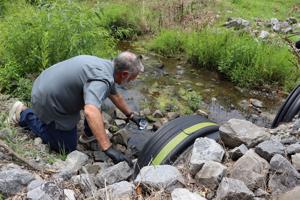Science
Call for Global Ban on PFAS Amid Rising Health Risks

Public health advocates are increasingly calling for a universal ban on per- and polyfluoroalkyl substances (PFAS), commonly referred to as “forever chemicals,” due to their widespread use and harmful effects. Despite improvements in monitoring and remediation techniques, experts argue that immediate action is necessary to address the escalating crisis linked to these substances.
PFAS are used in a variety of everyday products, including nonstick cookware, waterproof clothing, and cosmetics. There are over **10,000** different types of PFAS, and they are notorious for their resistance to degradation. As a result, these chemicals have been detected in blood, human breast milk, and even remote locations like Antarctica. Recently, the National Institute for Public Health and the Environment in the Netherlands warned residents not to consume eggs from backyard chickens, which showed alarming levels of PFAS contamination. Investigations suggest that earthworms, a common food source for these hens, might be contaminated.
In England, environmental analyses reveal that nearly all rivers, lakes, and ponds exceed proposed safety limits for PFAS. Reports indicate that **85%** of these water bodies contain levels **at least five times** higher than acceptable standards. In France, authorities have banned tap water in **16** communes due to similar concerns.
“PFAS have been linked to increased risk of various types of cancer, fertility problems, and weakened immune systems,”
said health experts. The health implications are severe, drawing parallels to climate change in terms of long-term environmental impacts and corporate cover-ups.
Documents from major manufacturers such as **3M Co.** and **DuPont de Nemours Inc.** reveal these companies were aware of the toxicity and accumulation of PFAS in humans for decades. While 3M maintains that its PFAS products are safe for everyday use, the company announced plans to discontinue PFAS use by the end of **2025**.
The financial burden of PFAS pollution is staggering. The global PFAS market is valued at just over **$28 billion**, while the cost of cleanup in the UK and Europe could reach **€100 billion** (approximately **$116 billion**) annually if current practices continue. Additionally, the **Nordic Council of Ministers** estimates health care costs related to PFAS could exceed **€52 billion** each year.
Some companies are responding to public pressure. Outdoor gear retailer **Patagonia Inc.** and fast-food chain **McDonald’s Corp.** are among those committing to phase out PFAS from their products. However, others have been slower to act, and a significant lobbying effort has emerged against proposed restrictions across Europe.
Despite some progress, current regulations remain fragmented. Denmark plans to ban the import and sale of PFAS-treated clothing and waterproofing agents starting in **July 2026**. The country has also prohibited the use of PFAS in food packaging since **2020**. France has implemented bans on several consumer products containing PFAS, but cookware remains exempt due to lobbying efforts by manufacturers.
A significant move toward a comprehensive ban is underway. In **2023**, five European Union member states—**Germany, the Netherlands, Sweden, Denmark,** and **Norway**—submitted a proposal to the **European Chemicals Agency**. This proposed ban seeks to regulate all PFAS collectively rather than on an individual basis, which, according to **CHEM Trust**, would take over **40,000 years** if each chemical were evaluated separately.
If the proposal proceeds smoothly, the new regulations may not take effect until **2028**. Meanwhile, the UK government has faced criticism for its interim position on PFAS management, which many scientists argue lacks urgency and fails to address the full spectrum of PFAS chemicals.
In the United States, the previous administration cut funding for PFAS research, and the **Environmental Protection Agency** has moved to rescind drinking water limits for several PFAS. The current political climate has further complicated efforts to mitigate PFAS contamination.
Even a complete ban on PFAS will not eliminate the substances already present in the environment and human bodies. Nonetheless, evidence suggests that restrictions can lead to significant decreases in exposure. For instance, a **2023** study indicated that blood concentrations of PFOS and PFOA, two common PFAS, have declined in Denmark over time.
In summary, the urgency for a universal ban on PFAS grows as the evidence of their harmful effects mounts. Addressing this crisis requires immediate and coordinated action on a global scale. Without a comprehensive strategy, the legacy of these chemicals will continue to impact public health and the environment for generations to come.
-

 Technology5 months ago
Technology5 months agoDiscover the Top 10 Calorie Counting Apps of 2025
-

 Technology3 weeks ago
Technology3 weeks agoOpenAI to Implement Age Verification for ChatGPT by December 2025
-

 Health3 months ago
Health3 months agoBella Hadid Shares Health Update After Treatment for Lyme Disease
-

 Health3 months ago
Health3 months agoAnalysts Project Stronger Growth for Apple’s iPhone 17 Lineup
-

 Health4 months ago
Health4 months agoErin Bates Shares Recovery Update Following Sepsis Complications
-

 Technology5 months ago
Technology5 months agoDiscover How to Reverse Image Search Using ChatGPT Effortlessly
-

 Technology3 months ago
Technology3 months agoElectric Moto Influencer Surronster Arrested in Tijuana
-

 Technology5 months ago
Technology5 months agoMeta Initiates $60B AI Data Center Expansion, Starting in Ohio
-

 Technology2 months ago
Technology2 months agoDiscover 2025’s Top GPUs for Exceptional 4K Gaming Performance
-

 Technology5 months ago
Technology5 months agoRecovering a Suspended TikTok Account: A Step-by-Step Guide
-

 Health5 months ago
Health5 months agoTested: Rab Firewall Mountain Jacket Survives Harsh Conditions
-

 Lifestyle5 months ago
Lifestyle5 months agoBelton Family Reunites After Daughter Survives Hill Country Floods





















